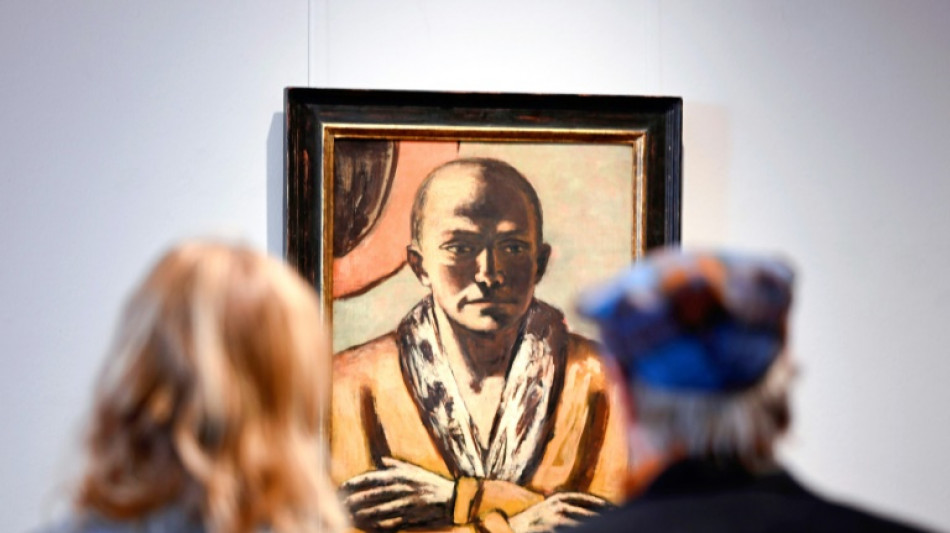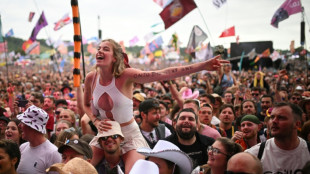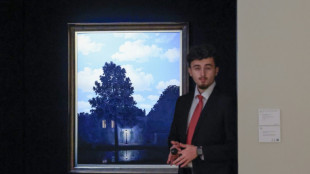
-
 Rio under high security for G20 summit
Rio under high security for G20 summit
-
G20 leaders to grapple with climate, taxes, Trump comeback

-
 Hopes set on G20 spurring deadlocked UN climate talks
Hopes set on G20 spurring deadlocked UN climate talks
-
Gabon early results show voters back new constitution

-
 Child abuse police arrest star Australian broadcaster
Child abuse police arrest star Australian broadcaster
-
Disgraced Singapore oil tycoon to be sentenced for fraud

-
 Stray dogs in Giza become tourist draw after 'pyramid puppy' sensation
Stray dogs in Giza become tourist draw after 'pyramid puppy' sensation
-
UN Security Council to weigh call for immediate Sudan ceasefire

-
 Is AI's meteoric rise beginning to slow?
Is AI's meteoric rise beginning to slow?
-
Israeli strikes on Beirut kill six, including Hezbollah official

-
 Rain wipes out England's final T20 in West Indies
Rain wipes out England's final T20 in West Indies
-
US speaker opposes calls to release ethics report on Trump's AG pick

-
 McDonald's feast undercuts Trump health pledge
McDonald's feast undercuts Trump health pledge
-
Thousands march through Athens to mark student uprising

-
 NBA fines Hornets' Ball, T-Wolves' Edwards, Bucks coach Rivers
NBA fines Hornets' Ball, T-Wolves' Edwards, Bucks coach Rivers
-
China's Xi says to 'enhance' ties with Brazil as arrives for G20: state media

-
 Bills snap nine-game Chiefs win streak to spoil perfect NFL start
Bills snap nine-game Chiefs win streak to spoil perfect NFL start
-
Biden answers missile pleas from Ukraine as clock ticks down

-
 Senegal ruling party claims 'large victory' in elections
Senegal ruling party claims 'large victory' in elections
-
Dutch plan 'nice adios' for Nadal at Davis Cup retirement party

-
 Trump meets PGA boss and Saudi PIF head amid deal talks: report
Trump meets PGA boss and Saudi PIF head amid deal talks: report
-
UN chief urges G20 'leadership' on stalled climate talks

-
 Steelers edge Ravens, Lions maul Jaguars
Steelers edge Ravens, Lions maul Jaguars
-
No.1 Korda wins LPGA Annika for seventh title of the season

-
 Biden touts climate legacy in landmark Amazon visit
Biden touts climate legacy in landmark Amazon visit
-
England secure Nations League promotion, France beat Italy

-
 Star power fails to perk up France's premiere wine auction
Star power fails to perk up France's premiere wine auction
-
Rabiot brace fires France past Italy and top of Nations League group

-
 Carsley relieved to sign off with Nations League promotion for England
Carsley relieved to sign off with Nations League promotion for England
-
Sinner says room to improve in 2025 after home ATP Finals triumph

-
 Senegal counts votes as new leaders eye parliamentary win
Senegal counts votes as new leaders eye parliamentary win
-
Biden clears Ukraine for long-range missile strikes inside Russia

-
 Lebanon says second Israeli strike on central Beirut kills two
Lebanon says second Israeli strike on central Beirut kills two
-
Puerto Rico's Campos wins first PGA title at Bermuda

-
 Harwood-Bellis risks wedding wrath from Keane after England goal
Harwood-Bellis risks wedding wrath from Keane after England goal
-
'Nobody can reverse' US progress on clean energy: Biden

-
 NBA issues fines to Hornets guard Ball, T-Wolves guard Anthony
NBA issues fines to Hornets guard Ball, T-Wolves guard Anthony
-
Biden allows Ukraine to strike Russia with long-range missiles: US official

-
 Britain dump out holders Canada to reach BJK Cup semi-finals
Britain dump out holders Canada to reach BJK Cup semi-finals
-
Biden clears Ukraine for missile strikes inside Russia

-
 Ukrainians brave arduous journeys to Russian-occupied homeland
Ukrainians brave arduous journeys to Russian-occupied homeland
-
Australia not focusing on Grand Slam sweep after thrashing Wales

-
 Wales's rugby woes -- three talking points
Wales's rugby woes -- three talking points
-
Jannik Sinner, the atypical Italian star on top of the tennis world

-
 'Devil is in the details,' EU chief says of S.America trade deal
'Devil is in the details,' EU chief says of S.America trade deal
-
Kusal Mendis defies injury as Sri Lanka beat New Zealand to clinch ODI series

-
 Gatland would back change after Australia condemn Wales to record defeat
Gatland would back change after Australia condemn Wales to record defeat
-
England rout Ireland to earn Nations League promotion in Carsley farewell

-
 England secure Nations League promotion, Haaland inspires Norway
England secure Nations League promotion, Haaland inspires Norway
-
Sinner sweeps past Fritz to win ATP Finals


Wartime Beckmann portrait poised for auction record
A remarkable wartime self-portrait of painter Max Beckmann will be auctioned in Germany next week, valued at a record-setting estimate of up to 30 million euros.
"Selbstbildnis gelb-rosa" (Self-Portrait Yellow-Pink), widely considered a masterpiece and in private hands since it was painted in 1943, features the artist during his Dutch exile from Nazi Germany.
It was initially a gift to his wife Mathilde, known as Quappi, who kept it until her death in 1986. The picture has been in a private Swiss collection for decades, and not shown in public since the mid-1990s.
"No comparable artwork has been offered on the German auction market since 1945," said Micaela Kapitzky, director and partner of Berlin's Grisebach auction house, which is handling the sale on December 1.
Its potential selling price has been valued at a whopping 20-30 million euros ($21-31 million) -- the highest pre-sale estimate for an artwork ever offered in Germany and for a Beckmann work worldwide, according to Grisebach.
The painting was displayed behind glass at a public preview this week to guard against vandalism by climate activists who have been targetting artworks.
Private collections, museums and other institutions around the world have expressed interest in acquiring the painting. Its historical and social significance have sent its value soaring, amid a booming German art market profiting from Brexit woes.
Beckmann's time in Holland was marked by relief at escaping Nazi Germany but frustration at being unmoored -- an ambivalence that surfaced in striking ways in his work, Kapitzky told AFP.
"He flees the Nazis and then is surrounded by them again (in occupied Holland) and yet somehow he manages to find this surprising inner peace," she said of the picture at auction.
"He knows of his importance as a painter. There's even a subtle smile that you can see."
- 'Still I live' -
Kapitzky said the self-portrait was also a testament to the "intimate" love story between Beckmann and Quappi against the backdrop of World War II's horrors.
"Quappi always kept it, until her death. She never separated from it," Kapitzky said. "Max Beckmann was a very self-confident man but he needed Quappi at his side."
Beckmann (1884-1950) enjoyed massive acclaim in Germany during his lifetime, with top dealers placing his work with private collectors and major institutions.
That was until the Nazi regime labelled his daring, politically charged art "degenerate" and removed them from German museums in 1937.
Professionally thwarted and increasingly under threat, Beckmann left for Amsterdam, where he lived in self-exile for a decade before moving to the United States.
"Silent death and conflagration all around me and yet still I live," Beckmann wrote in his diary after German troops overran Holland in 1940.
In Amsterdam, Beckmann did not face poverty, as many of his 20,000 fellow German refugees did, nor was he under threat of deportation to a concentration camp like his Jewish friends.
It proved a prolific decade, accounting for roughly one-third of his total output.
But unlike the sombre black tones of many paintings created there, a sunnier palate dominates the self-portrait going under the hammer.
His clothing, perhaps a dressing gown, is trimmed with bright fur in what could be seen as an expression of tenacious defiance.
"When it first arrived, I thought 'wow, it is amazing what power this picture exudes'," Markus Krause, who will conduct the auction, told AFP.
- Anti-Nazi statements -
Beckmann would ultimately die in New York at the age of 66, of a heart attack on a sidewalk on his way to the Metropolitan Museum of Art where his "Self-Portrait in Blue Jacket" was exhibited.
Paintings by Beckmann, now considered one of the most important artists of the 20th century, have exploded in value in recent decades.
His "Bird's Hell", ranked among Beckmann's most important anti-Nazi statements, sold at Christie's in London in 2017 for 36 million pounds ($46 million, 41 million euros at the time) and set a new auction record for German Expressionism.
Its pre-sale estimate was significantly lower than Self-Portrait Yellow-Pink, Kapitzky noted.
She said many art buyers and sellers were now turning their backs on London in the wake of Brexit due to complications with shipments and customs clearance.
"And so yes, the German market is beginning to benefit from it."
H.Romero--AT



